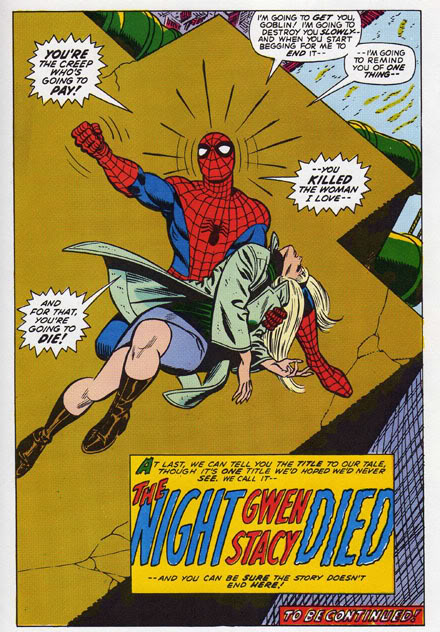How Did Gwen Stacy Die? A Pivotal Point in Comic History

Join the community on Reddit for the latest Marvel & DC news!
Whether you have watched ‘The Amazing Spider-Man 2′ starring Andrew Garfield and Emma Stone or have been an avid reader of comics, by now, you must be aware that Gwen Stacy dies. In fact, she dies in ‘Amazing Spider-Man #121,’ released in June of 1973. As the story goes, Stan Lee (creator of Marvel Comics) was preparing to head to Europe for a business trip. Writer Gerry Conway, Editor Roy Thomas, and Inker John Romita Sr. approach him with the idea of killing off Gwen Stacy. In a hurry and wanting to leave, Lee gave them the green light. Unaware of what he just did, he left for Europe. So, what exactly happened, and how did Gwen Stacy die?
Gwen Stacy died due to the whiplash effect caused by Spider-Man catching stopping her fall too quickly mid-air. Gwen Stacy was hurled off the bridge by Green Goblin, and in an effort to save her from certain death, Spider-Man shot the web, caught her feet, and pulled her up, realizing she was dead. The later issues would go on to state that Gwen, in fact, died due to the fall itself, however, the first version of the events that transpired remained the most iconic.
When back on U.S. soil, Lee was surprised to find out that they had, in fact, done it. He immediately questioned them as to why. This caused the three to remind him that he had greenlit it. If you want to know more about one of the most impactful events in comic book history, stay with us and keep reading!
The death of Gwen Stacy changed everything
Conway has gone on record stating that killing Gwen Stacy was quintessential to the Spider-Man story. What made Spider-Man’s books so popular was the relatability of his character, along with the recurring theme of personal tragedy. If you have not read/ watched the story unfold, let me paint a picture for you. The Green Goblin (perhaps Spider-Man’s greatest enemy) has taken Gwen captive and brought her to the top of the Brooklyn Bridge. At this point, the Goblin and Spider-Man begin to fight, and ultimately, the Goblin throws Gwen off the bridge.
Seeing the love of his life falling to her demise, Spider-Man takes aim with his web-shooters and catches her. He brings her back up to not only find out that she had perished during the fall but that Gwen Stacy’s death was a result of his web breaking her fall and neck.

This story has been well-documented since its inception. So, why was this such an important event in the history of comics?
Death of Gwen Stacy did so much
The Gwen Stacy death is widely thought of as doing the following: It is considered the moment when comic books left the more innocent ‘Silver Age’ and entered the darker ‘Bronze Age.’ It is shown that even though his best intentions, Spider-Man cannot stop all tragedies. At the time, it was considered unimaginable to kill off such an important character. This story opened the floodgates of the main characters’ deaths. So then, why was it a story that had to happen?
The 1970s was a time of transformation for the United States. Behind it was simpler times, and ahead of it lay political turmoil. The themes that faced the U.S. transcended into mainstream popular culture. Marvel Comics began to act out against authority. Its efforts started when it dropped the Comics Code Authority stamp of approval from its comic books.
The stamp was designed to sit in the upper right corner of every comic book to show its readers that there was no overt violence, drugs, sex, or foul language. Marvel made three issues (‘Amazing Spider-Man’ 96, 97, and 98) in which the stamp was not on the book’s cover.
Doing this opened up a world of opportunity for Marvel and comics (DC followed shortly thereafter with the release of a ‘Green Lantern’ storyline that focused on heroin addiction). Comics began to focus less on childish stories and more on mature ones. We began to see issues that discussed: Racism, Drugs, Poverty, Sex, etc…
The death of Gwen Stacy led to a new way of thinking
Following this, Gwen Stacy’s death suddenly makes the readers think that perhaps it isn’t possible to always come out on top. Here was Spider-Man, the everyday good guy, facing a situation he could not come out on top of.
No matter what happened, Gwen was destined to die. If he had jumped off to save her, he would not have caught up with her, and when he shot out his web, the whiplash broke her neck.
Stan Lee made it a mission to have the character of Gwen Stacy illicit an emotional response from his readers when she walked into a room, uttered a single word, or was placed in certain danger.
Gwen brought the proverbial ‘silver lining’ to the dark cloud of Spider-Man’s life. She was an incarnation of love in a seemingly dark existence. She was the poster child for the superhero girlfriend, and one that fans all over the world fell in love with.
The Gwen Stacy death made readers aware that superheroes faced real-world problems. Children learned more in that night about life and death than they had learned in their short lifetimes. It became apparent that superheroes were not immune to societal issues, and superheroes could not escape tragedy. Spider-Man did not just feel her death but rather was felt by every fan across the globe.
A monumental shift
Interestingly enough, the ‘Snap’ heard at the site of her neck in the book is not noticed or touched upon by either Spider-Man or the Green Goblin. This tiny detail has led to endless debates over the years about whether Spider-Man knows/acknowledges/accepts that he killed his girlfriend.
This moment in time caused a shift in the Spider-Man character. Suddenly, he knew and lived for vengeance. No longer was he the go-lucky superhero that children grew up loving. It was at this moment that he ‘grew up.’ The Gwen Stacy death will live in infamy as the turning point in comic book writing, drawing, and creation.
What do you think about ‘The Night Gwen Stacy Died’? Let us know in the comments below!
Liked this article? Join the community on Reddit for the latest Marvel & DC news!

